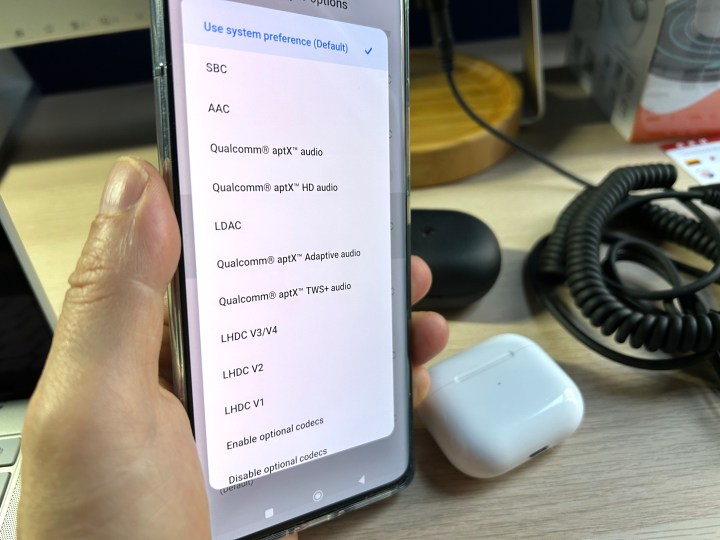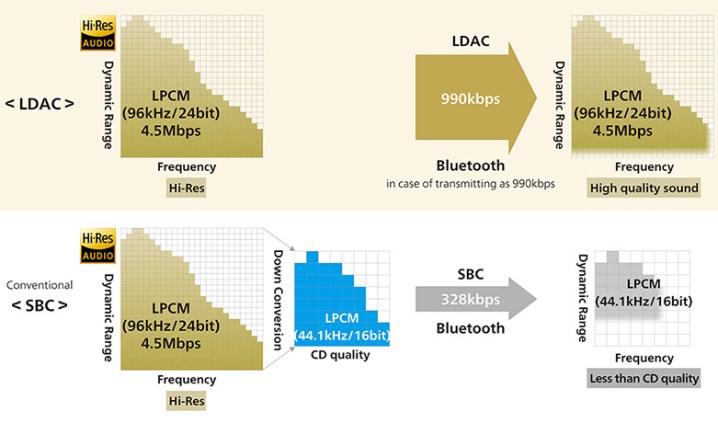When it comes to Bluetooth codecs, most wireless earbuds and headphones will support AAC and/or aptX (in addition to the standard SBC codec that all devices support). These three codecs differ in how they compress the audio that travels from your phone to your headphones, but they all have one thing in common: They only support a bit depth of 16 bits. That’s enough resolution for most kinds of audio, and many experts believe it’s enough, period.
Not everyone is convinced that hi-res audio actually sounds better, but if you’ve got access to a source of lossless, 24-bit music, whether from your own personal files or from a streaming music service, you may want to consider buying a set of buds or
Qualcomm, which designs chips for mobile phones and other wireless devices, is the driving force behind the aptX family of codecs. Sony created LDAC, and you will find that the company uses it extensively on its own products.
But which of these codecs is the best? That depends on a lot of factors, so let’s start at the beginning.
Compatibility and availability

The first thing you should know about these three codecs is that none are currently supported by Apple on its devices. If you own an iPhone or iPad, or even a Mac, you are most likely limited to the 16-bit AAC codec. On some older Macs running macOS versions earlier than Catalina, it’s possible — with some work — to get aptX support, but even then, you’re still limited to 16-bit audio.
AptX HD and LDAC were both added by Google to Android 8.0, letting any
AptX Adaptive is the newest of the three codecs, and while it also runs on
Any wireless headphones or earbuds that support aptX Adaptive must also use Qualcomm’s chips. From a compatibility and availability point of view, this puts aptX Adaptive at a bit of a disadvantage.
AptX HD has limitations too, but in this case, it’s strictly on the
LDAC has no real constraints on either side of the Bluetooth equation. It works on
Availability is a slightly different story. Not many manufacturers have chosen to adopt LDAC. Other than Sony itself, the list includes 1More, Anker Soundcore, Soundpeats, Shure, Audio-Technica, Technics, Edifier, Ausounds, Ankbit, and Philips. Meanwhile, aptX HD has been used by more than 30 headphone manufacturers, and aptX Adaptive has been used by even more companies when you count both
In theory, with LDAC’s ability to run on
Winner: aptX Adaptive
Sound quality part 1: resolution and frequency

Sound quality is a highly subjective topic and can be influenced by a variety of factors. For instance, if you’re using a set of budget
When a codec is used to transmit audio wirelessly, it encodes that audio at a specific resolution (bit depth) and a specific sample frequency (kHz). Generally speaking, the higher these numbers, the more information will be preserved, and the better your audio has the potential to sound.
AptX HD operates at 24 bits and up to 48kHz. By any standards, that should be more than enough to capture and transmit very high-quality audio. However, in order to technically be considered “hi-res,” a codec needs to support sample frequencies above 48kHz. LDAC and aptX Adaptive both meet that criteria, with a top quality of 24-bit/96kHz. Whether you’ll be able to hear that difference or not is highly debatable, but if you’re listening to 24-bit/96kHz or better audio and want to preserve as much of that signal as possible, LDAC and aptX Adaptive are the way to go.
Winner: Two-way tie between LDAC and aptX Adaptive
Sound quality part 2: bit rate and scalability
The nerds out there are probably yelling at me right now because while resolution and sample frequency might be the be-all and end-all for sound quality when dealing with hi-res audio files, the moment Bluetooth gets involved, you also need to take into account how a codec handles itself under highly variable wireless conditions.
We’re talking about bit rate, or the amount of data a codec uses to send information across a Bluetooth connection. The higher the bit rate, the more information can be sent, and thus the better the sound quality.
Some codecs have fixed bit rates, which means that they can’t react to changes in the quality of a wireless link. AptX HD is a fixed bit rate codec, and it requires a constant speed of 576Kbps when using a 48kHz sampling frequency. As long as your connection can handle this speed, aptX HD should be able to deliver its full quality. But if the quality of your connection drops below that speed, which can happen when you’re too far from your phone or there’s a lot of wireless interference, the audio will start to break up. It’s an all-or-nothing proposition.
LDAC and aptX Adaptive are scalable codecs — they can adjust the amount of bandwidth they use in response to your Bluetooth connection. The difference between them is that LDAC steps between three specific speeds: 330Kbps, 660Kbps, and 990Kbps, with no in-between steps, while aptX Adaptive can dynamically adjust its speed from as low as 110Kbps and as high as 620Kbps in 10Kbps increments.
It’s rare that a Bluetooth connection can be maintained at LDAC’s top speed of 990Kbps — this really requires ideal conditions. Unless you force your phone to only use the 990Kbps speed (which is possible using the optional developer settings), LDAC will typically run at 660, and even that may be difficult to maintain.
AptX Adaptive’s ability to smoothly scale instead of stepping in such large increments, and its lower overall speed requirements means it will be able to connect at its top quality more of the time while presenting a far less noticeable transition when it needs to ramp its speed downward.
On paper, LDAC’s 990Kbps bitrate is clearly the best of the three, with almost double the amount of data transmitted per second than aptX HD and almost 50% more than aptX Adaptive. However, there’s not much point in being able to achieve 990Kbps if conditions almost never allow it to happen. And as we’ll see in a moment, what you do with that bit rate is just as important.
Winner: aptX Adaptive
Sound quality part 3: efficiency
As the newest of the three codecs, you’d expect aptX Adaptive to be the most efficient (the ability to maintain the greatest amount of detail with the least amount of transmitted data), and it is. In some ways, it’s not even a fair comparison. Not only is aptX Adaptive newer in terms of its code, it only runs on Qualcomm’s chips, effectively giving it a home-field advantage.
Qualcomm claims that aptX Adaptive can deliver the same audio quality as aptX HD (576Kbps) at just 420Kbps. And though Qualcomm makes no direct claims about LDAC, we know that aptX Adaptive can deliver the same 24-bit/96kHz mode as LDAC’s 990Kbps at just 660Kbps.
We haven’t been able to find a scientific set of measurements that clearly shows how LDAC and aptX Adaptive perform at their respective top bit rates, but it’s worth repeating: If a codec can’t deliver its top level of quality without a very hard-to-reach bit rate, does it really matter?
Winner: aptX Adaptive
Latency

Latency is the time it takes for you to hear a sound after it has been created by your device. For regular music listening, latency doesn’t matter much, but if you’re gaming or watching any kind of video with dialogue, you want that time to be as short as possible. The general consensus within the gaming community is that anything lower than 32ms is fast enough to be comparable to using a wired headset.
Several factors can affect Bluetooth audio latency, but codecs are an important ingredient. AptX HD has a reported latency of anywhere between 200ms and 300ms. LDAC can exhibit similarly long lag times.
AptX Adaptive, on the other hand, can adjust its performance based on the kind of audio you’re streaming. If it detects that you’re gaming, making a phone call, or doing anything else that might require low latency over high resolution, it can operate as low as 80ms.
That’s enough to earn it a win in the latency category, but it might get even better. Qualcomm says that if you’re using a phone and
Winner: aptX Adaptive
Power consumption

One thing we’ll probably never get enough of when it comes to
For LDAC, this poses a challenge. Running LDAC on a set of earbuds or
The aptX family of codecs has always been more efficient than its rivals, and that goes for both aptX HD and aptX Adaptive. Low power consumption isn’t a key feature of Adaptive, but Qualcomm says it uses less power to deliver the same performance as aptX HD. These efficiencies will likely get better over time thanks to improvements in Qualcomm’s chips.
Winner: aptX Adaptive
Conclusion
In some ways, this wasn’t a fair comparison. As the newest of the three codecs, AptX Adaptive has several advantages that LDAC and aptX HD simply can’t match. It works on earbuds and
Our overall winner: aptX Adaptive
Editors' Recommendations
- Bluetooth Multipoint finally arrives on Sony’s best wireless earbuds
- MQair is the new hi-res Bluetooth audio codec for fans of MQA
- Lossless Bluetooth audio? Qualcomm says it’s coming in 2022
- Sony WH-1000XM4 vs. Bose Noise Cancelling Headphones 700: Battle of the best
- Sony WH-1000XM4 Vs. WH-1000XM3: What’s the difference and which should you buy?



